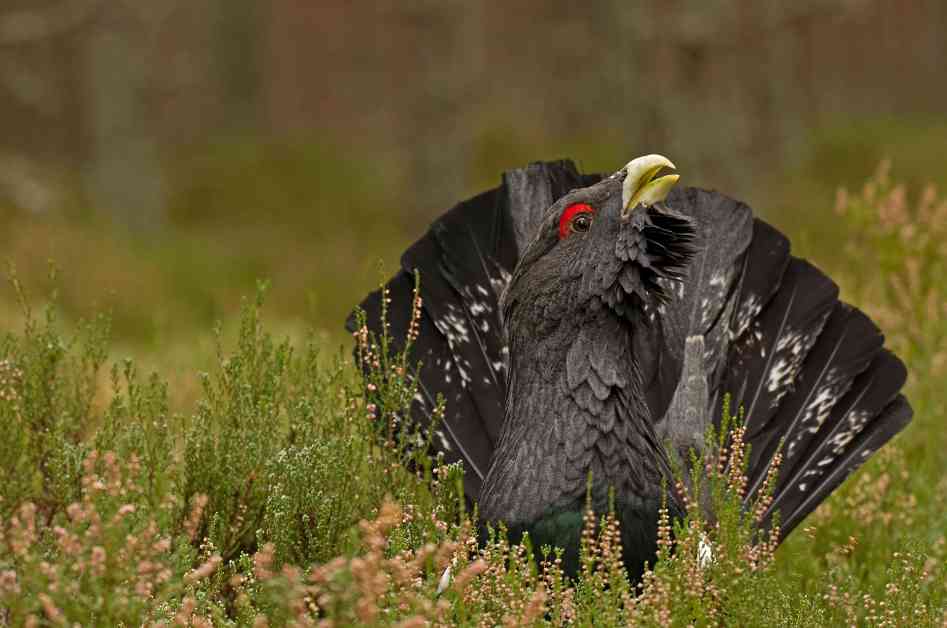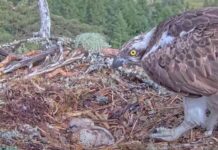An emergency rescue plan to save one of Scotland’s most iconic birds, the capercaillie, is currently being implemented as conservationists warn that the species is on the brink of extinction. Efforts are being made to ensure the survival of this native bird through a comprehensive five-year conservation plan that addresses various threats faced by the capercaillie population.
### Conservation Efforts
Conservationists acknowledge that there is no single solution to saving the capercaillie, but they believe that swift action in several key areas over the next five years could significantly increase the bird’s chances of survival. Among the proposed plans are measures to feed the animals that prey on capercaillie eggs and create more breeding spaces for the birds. Additionally, there is consideration of introducing capercaillie from Europe, where larger populations still exist, into the Highlands to bolster the native population.
The capercaillie, one of Scotland’s largest birds and the largest species of grouse, is facing threats from habitat loss, human encroachment into natural areas, and predation by pine martens and badgers. The majority of native capercaillie reside within the boundaries of the Cairngorms National Park, prompting collaboration between park leaders and the Scottish Government agency NatureScot to launch the five-year Emergency Plan.
### Roadmap for Conservation
The Emergency Plan outlines a roadmap of actions aimed at securing a brighter future for the capercaillie species, which currently numbers around 530 individuals in the wild. In addition to land management strategies to improve habitats, such as woodland grazing and forest bog restoration, the plan includes initiatives to mitigate the impact of predators through diversionary feeding. The Cairngorms Connect Predator Project has shown that diversionary feeding can increase the chances of artificial nest survival by 83%.
Preliminary findings suggest that the presence of diversionary feeding leads to a higher likelihood of finding capercaillie with young. NatureScot will take the lead in obtaining better information on pine marten populations in areas where they coexist with capercaillie to monitor changes in predator numbers over time. Furthermore, a study will assess the feasibility of reinforcing the Scottish capercaillie population with birds from outside the UK.
### Stakeholder Collaboration
Andy Ford, Director of Nature and Climate Change at the Cairngorms National Park Authority, emphasized the critical role of action within the National Park in protecting the capercaillie population. He highlighted the collective effort needed to safeguard the species, with the Cairngorms Capercaillie Project engaging more individuals in conservation efforts.
Eileen Stuart, NatureScot’s Deputy Director of Nature and Climate Change, underscored the collaborative nature of the Emergency Plan, which involved over 100 stakeholders from various sectors of capercaillie conservation. Stuart emphasized the urgency of the situation, noting that without significant action, the species could face extinction within the next 20 to 30 years. The Emergency Plan aims to address multiple challenges facing the capercaillie population and was developed in response to a request from the Scottish Government.
### Previous Conservation Efforts
The capercaillie has faced extinction predictions in the past, with conservation science forecasting its demise by the early 2010s in the early 1990s. Over the last five years, the Cairngorms Capercaillie Project has made strides in reducing disturbance levels in core capercaillie habitat by engaging with various stakeholders, including the mountain biking community, bird watchers, and dog walkers. Collaborative efforts have led to smarter decisions regarding trail development in capercaillie areas, resulting in a reduction of mountain biking disturbance over 450 hectares without sacrificing trail quality.
Emma Holgate, Chair of the Badenoch and Strathspey Trail Association, commended the Cairngorms Capercaillie Project for its success in protecting the environment while enhancing the local trail network. The strong partnerships forged through the project have enabled smarter trail management decisions, demonstrating the positive impact of collective efforts in conservation.
In conclusion, the implementation of the five-year Emergency Plan for the capercaillie signals a renewed commitment to saving this iconic species from the brink of extinction. With collaboration from stakeholders across various sectors, conservationists aim to address the multiple threats facing the capercaillie population and ensure a sustainable future for this unique bird in Scotland.
































